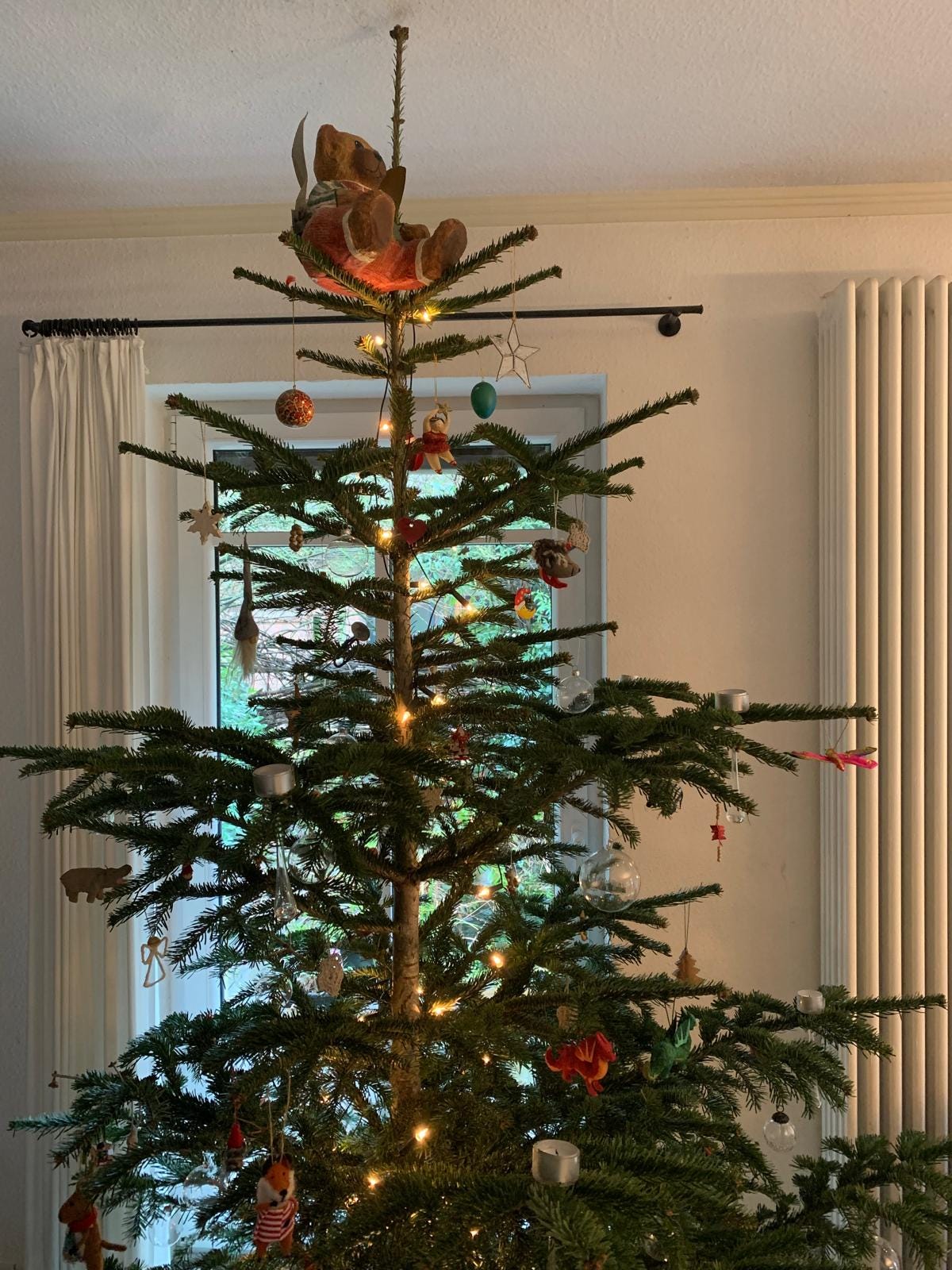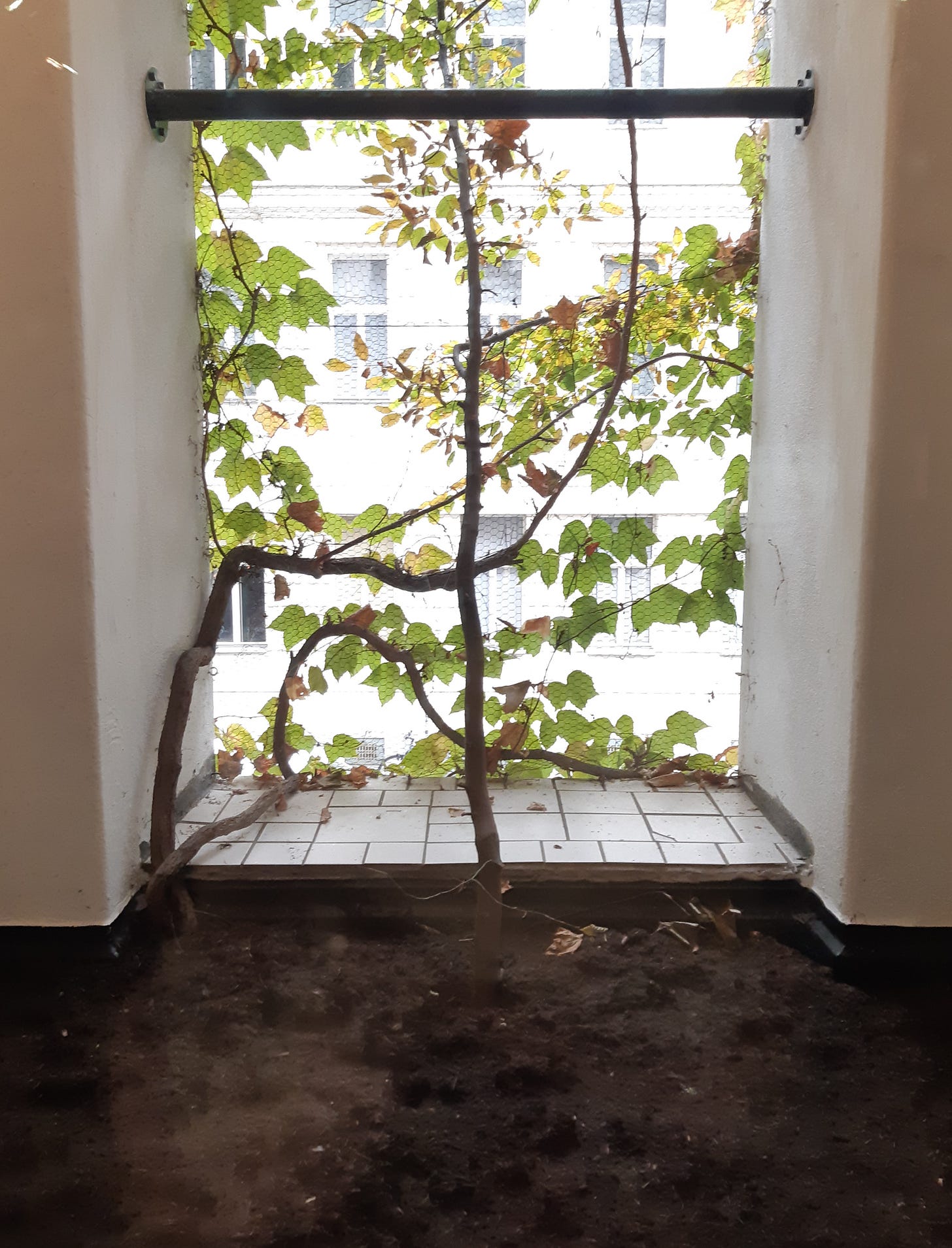If you’re like me, there’s a tree in your living room right now.
It’s full of glass and wood and felt ornaments and electric lights. Its cut stem is secured in a stand designed specifically for this purpose. The tree seems to be connected to the birth of Christ, which we celebrated a few days ago. Before this, it lived and grew in a monoculture of near-identical trees, some twenty kilometres from here. Now, I can smell its needles from my armchair in the corner, a comforting sensation. Soon they will start falling. The tree will begin to decay, change shape, and things will get a little awkward — it will have served its symbolic function, but lack the common courtesy of disappearing materially when ‘tis no longer the season.
Only noticing the the tree at the right moments is essential for a magical experience, and has been as long as we have invited trees into the house during winter: “We were not allowed to see how it was brought into and set up in the Christmas room. It stood tall on Christmas morning, literally enchanted by heaven”, reads an anecdote from the year 1899.1 The tree’s materiality, of course, extends beyond these moments in both temporal directions (assuming for simplicity’s sake that time is linear).
It grows for years before it is cut, and decays long past December. In January, after they are once again disenchanted by heaven, people are encouraged to pile their trees at designated locations throughout the city. “We will make compost and biomass out of them”, the municipality promises. The tree in the city’s living room awaits a slightly different fate: In January, the twenty-meter fir from the German Ardennes will be transported from Dam square into the enclosure of Artis’ Asian elephants, who (like me) enjoy the smell of its needles and like to play with its large branches.
So far, so good — that is to say, we’ve got a nearly carbon-neutral system in place of growing Christmas trees in plantations and recycling them into compost, which allows us to continue living with a tree in the house for a couple of weeks each December and ignore its material form for the rest of the year.
What makes the tree in the house worth all this space and effort? I think what it does for many, especially those living in cities, is provide an experience of resonance, to use a term by sociologist Hartmut Rosa: Experiencing oneself as connected to the world, to nature, and especially to other people. To this end we enter into a temporary and bizarre cohabitation, which is also the closest a lot of people, myself included, come to sharing their homes with a tree. Then again, I look at my tree over there in the living room and I can’t help but wonder: What if we actually lived together?
As usual, the best answers and experiments come from artists, and when I look at my Christmas tree, I think of Friedensreich Hundertwasser’s tree tenants. Architect as well as idealist, Hundertwasser designed houses in which both humans and trees have space to grow, like so:
Tree tenants dwell inside the walls of the house in an area of about one square meter behind the windows. The windows are set back and you can look at the tree tenant and outside. The tree tenant has one cubic meter of soil at his disposal and can become quite big. The tree tenant pays his rent in much more valuable currency than the humans.
1. Tree tenants create oxygen.
2. Tree tenants improve the city climate and the well being of dwellers.
They bring the needed moisture into the desert climate of the city, reduce the dry-humid and the cold-warm contrast.
3. Tree tenants act like vacuum cleaners. More so. They swallow even the finest and poisonous dust. There is less dust in the apartment and in the street.
4. Tree tenants swallow noise. They reduce the echoes of the city noise and create quietness.
5. Tree tenants protect you from outside view like curtains and create shelter.
6. Tree tenants give shadow in summer but let sunlight through in winter when leaves have fallen.
7. Butterflies and birds come back.
8. Beauty and joy of life come back. Living quality is improved with this piece of own nature.
9. The tree tenant is a symbol of reparation towards nature which is extremely visible. We restore to nature a tiny piece of the huge territories which man has taken away from nature illegally.2
For a demonstration of this, I highly recommend visiting the Museum Hundertwasser in Vienna, and taking off your shoes while you’re there.
My point is very simple: What if our Christmas trees were tree tenants, what if our cohabitation were not temporary and bizarre, but permanent and still bizarre, but less and less so — what if we dressed the tree tenant up two weeks out of the year but watered it year-round? What kind of care ensues when we encounter each other daily, and don’t reserve our encounters for enchantment, and what kind of conflict? What enchantment arises from that disenchantment, what does constant resonance feel like, what kind of moss might grow, what lichen, and will I have worm tenants, too? What if a living tree stood twenty meters tall on Dam square, sheltering the pigeons? And of course: Is a tree tenant really so different from any old house plant?
With that, I wish you a pleasant slide into the new year! Naive as it may be, I wish it for you exactly like this: Imagine a slide in a playground that transports you downwards with ease, not too fast but not too slow, so that it’s just a little bit thrilling. And at the bottom, the new year waits to catch you with open arms, and they are arms you look forward to being caught in. Now off we go!
Quote from Joe Perry (2010), Christmas in Germany: a cultural history, p.47.






